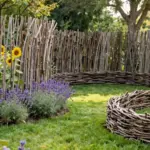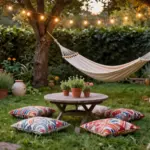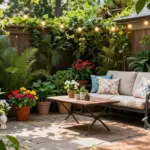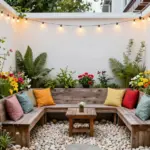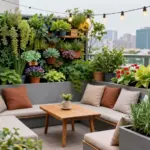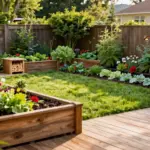Finding the perfect balance between privacy and a beautiful garden can be a challenge. Plant fences are the solution to this age-old dilemma, offering lush greenery while keeping your space cozy and secluded. From vertical gardens brimming with flowers to dense shrubs that act as natural barriers, there are diverse plant fence ideas to explore.
Whether you’re looking for decorative garden fences, natural privacy barriers, or innovative outdoor plant designs, this guide highlights 30 creative plant fence ideas. These concepts not only enhance your garden but also contribute to sustainable landscaping. Let’s get inspired to create a serene retreat right in your backyard!
1. Vertical Herb Wall
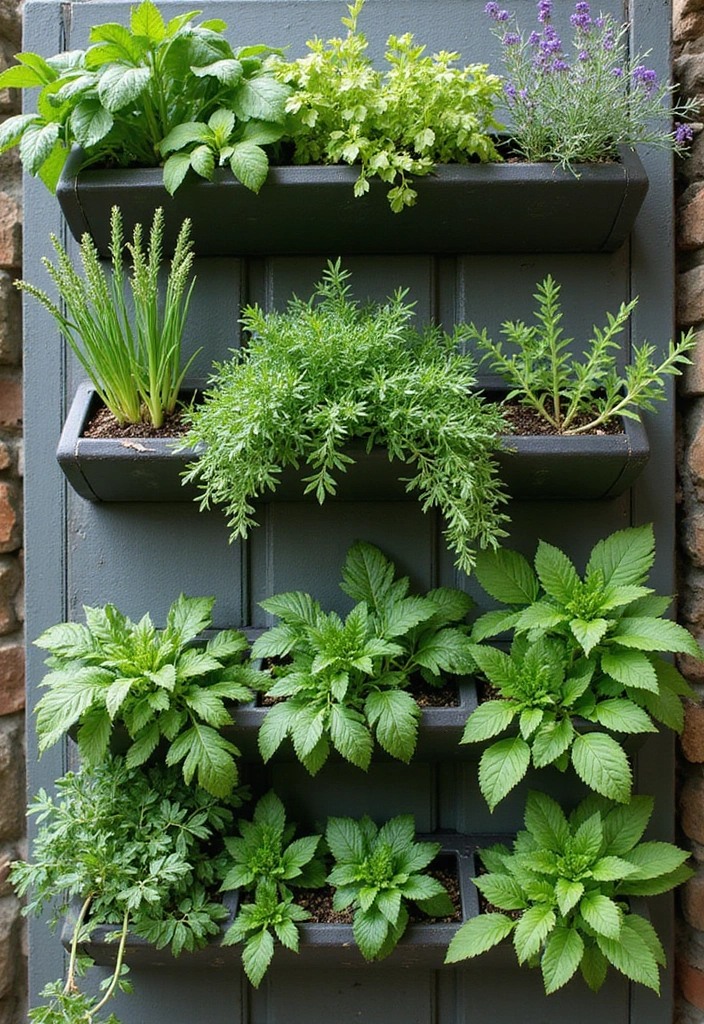
A vertical herb wall is a fantastic way to maximize space while adding a delightful scent to your garden. Utilizing wall-mounted planters, you can grow fresh herbs like basil, rosemary, and thyme right outside your kitchen. This natural privacy solution not only gives you greenery but also keeps your herbs close at hand for cooking.
Here are some tips for creating your vertical herb wall:
– Use sturdy wall-mounted planters or pallets.
– Choose herbs that thrive in similar sunlight conditions.
– Regularly trim to encourage growth and prevent overgrowth.
– Ensure proper drainage to keep the herbs healthy.
This setup can transform a plain wall into a fragrant wall of greenery, offering both beauty and functionality.
2. Bamboo Privacy Screen

Bamboo is an excellent choice for creating a natural privacy barrier. It grows quickly and densely, making it perfect for those seeking an instant green wall. Not only does bamboo provide privacy, but it also adds an exotic touch to your garden.
Consider these points when using bamboo:
– Choose a species that suits your climate.
– Plant in a well-drained area to avoid waterlogging.
– Regularly trim to maintain height and density.
– Plant in clusters for a fuller appearance.
With its tall and slender growth, bamboo can beautifully frame your outdoor space, making it a stylish addition to any garden.
3. Climbing Vines on Trellises
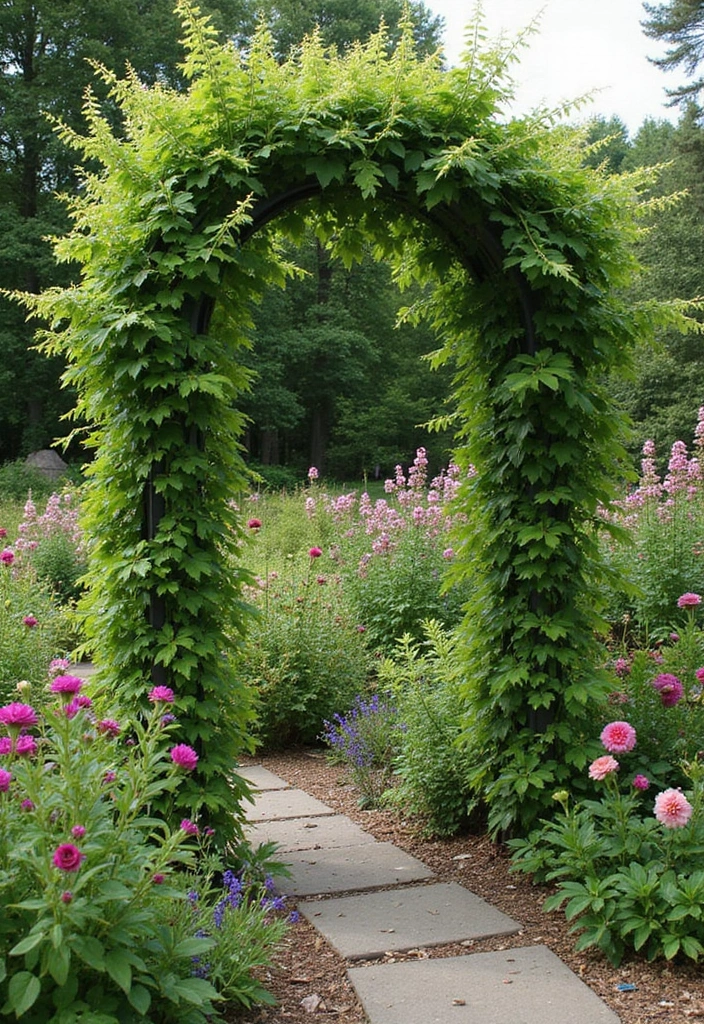
A trellis adorned with climbing vines is a classic way to add beauty and privacy to your garden. Vines like wisteria, clematis, and climbing roses can completely transform a simple fence into a stunning natural wall. The beauty of using climbing plants is they can create a dynamic look that changes with the seasons.
Key tips for successful climbing vines:
– Secure a sturdy trellis or fence for support.
– Plant at the base of the trellis and guide the vines as they grow.
– Prune regularly to encourage new growth and blooming.
– Select a variety of plants for a more colorful display.
This option not only offers privacy but also encourages wildlife, making your garden a vibrant ecosystem.
4. Succulent Border Fence

For a unique and low-maintenance garden fence, consider using succulents. These hardy plants can be arranged in a border to create a colorful and textured privacy barrier. Succulents thrive in well-drained soils and require minimal watering, making them perfect for those in warmer climates.
Here’s how to create a succulent border:
– Choose a variety of succulents for different colors and textures.
– Ensure they’re planted in a sunny location with good drainage.
– Use stones or decorative rocks to define the border.
– Plan for seasonal color changes to maintain interest.
Succulents can create an eye-catching fence that not only provides privacy but also showcases your unique style.
5. Floral Living Fence
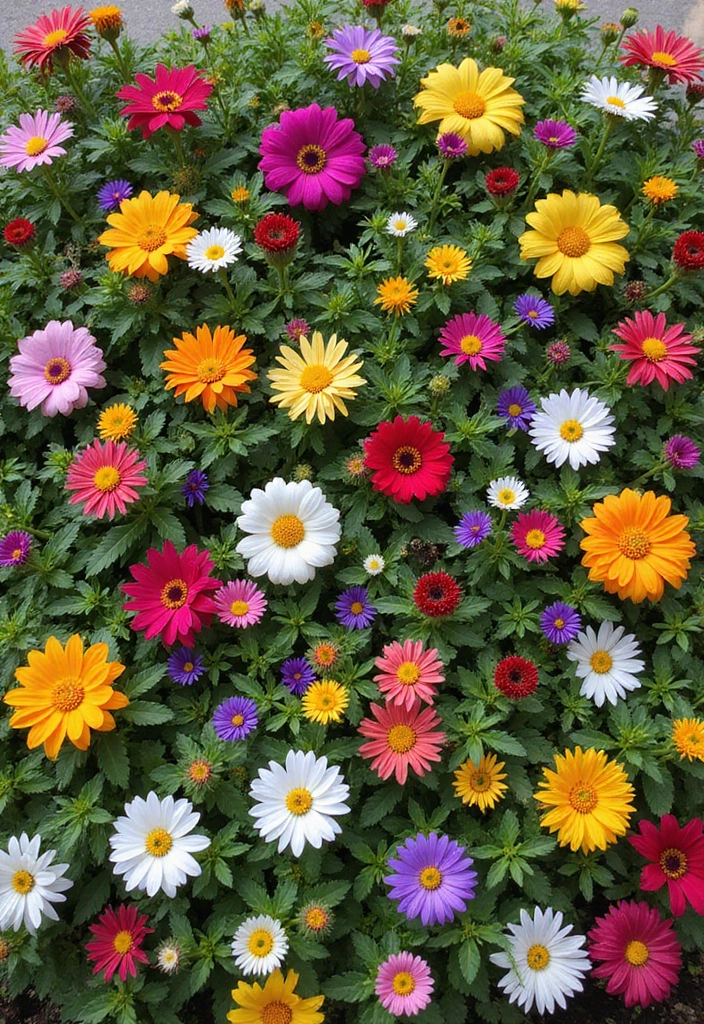
Creating a floral living fence is not just about privacy but also about beauty. Planting a mix of perennials and annuals can create a vibrant, blooming wall that shifts colors throughout the year. Flowers like lavender, sunflowers, and daisies can be included for both aesthetics and fragrance.
To design a floral living fence:
– Choose a mix of heights and colors for visual interest.
– Ensure there’s enough sunlight for all plants.
– Use mulch to help retain soil moisture.
– Plan for seasonal planting to keep blooms coming.
This design offers an inviting charm, making your garden a delightful sanctuary.
6. Rustic Wooden Planter Boxes
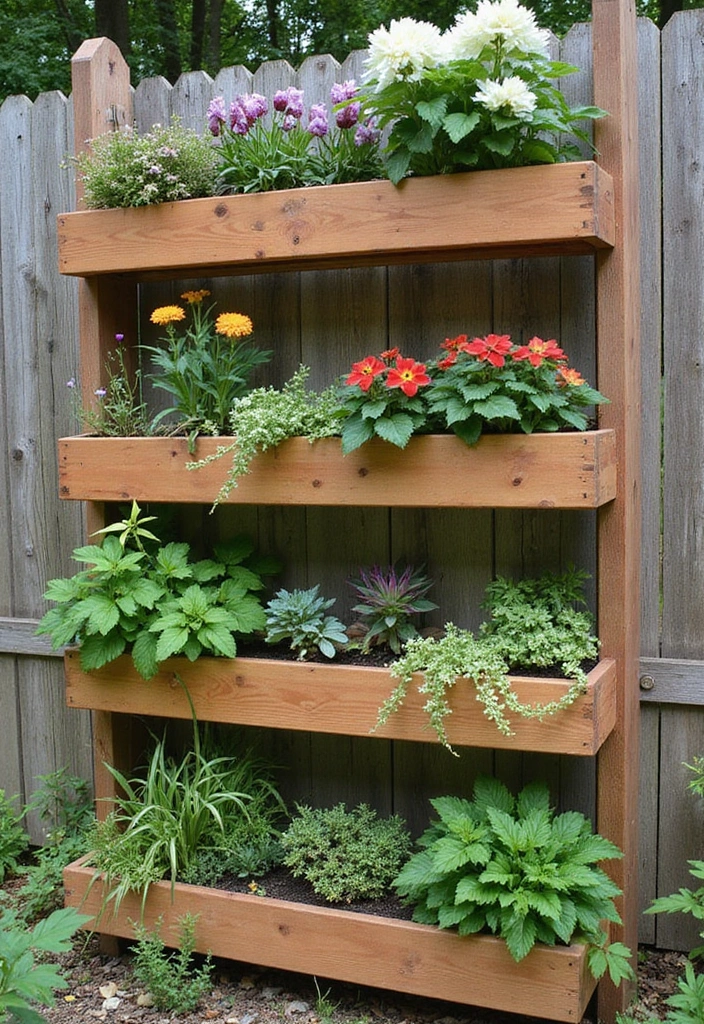
Wooden planter boxes don’t just hold your plants but can also act as a decorative fence. Stack them or line them up to create a natural border that offers both privacy and charm. You can fill these boxes with climbing plants, flowers, or small shrubs.
Here’s how to create rustic planter boxes:
– Use reclaimed wood for a rustic look.
– Ensure proper drainage holes are drilled.
– Mix different plants for a layered effect.
– Consider height variations for a more dynamic appearance.
This option is both functional and delightful, offering a warm and inviting feel to any outdoor space.
7. Lattice Fence with Hanging Baskets

A lattice fence combined with hanging baskets can elevate your garden decor while providing privacy. This dual-purpose structure allows light to filter through while offering a space to showcase colorful flowers or trailing plants. The combination of structure and greenery adds depth to any garden.
Things to consider:
– Choose lightweight baskets for ease of hanging.
– Select plants that will thrive in hanging conditions.
– Regularly check for watering needs and dead blooms.
– Use a mix of cascading and upright plants for variety.
This idea not only creates privacy but also a whimsical charm that can brighten any space.
8. Dense Evergreen Shrubs
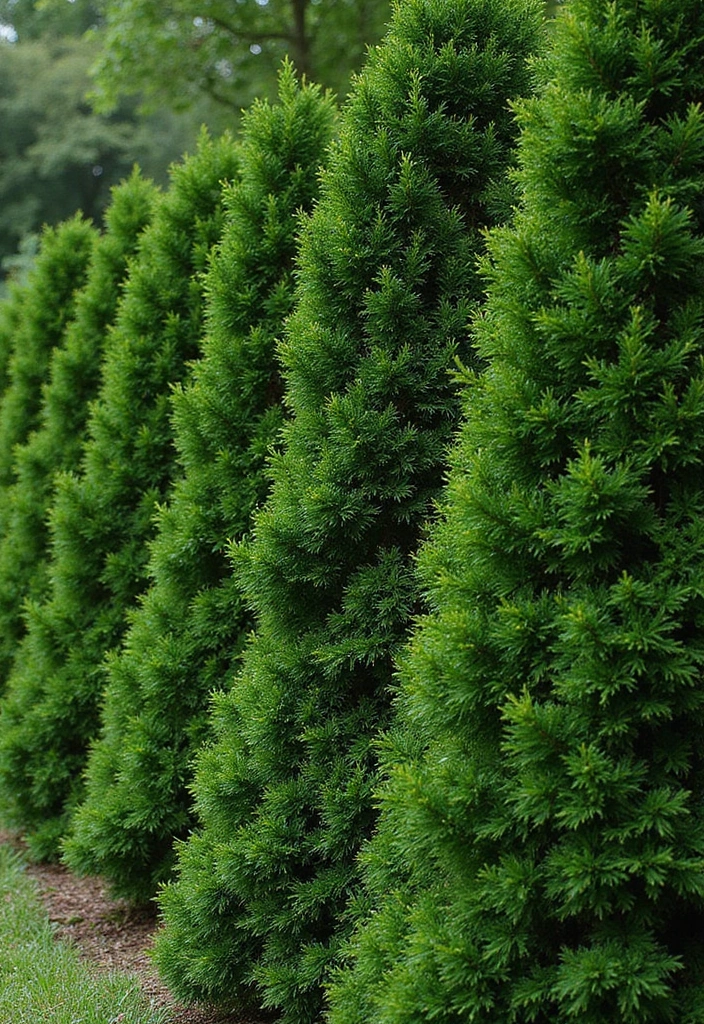
Dense evergreen shrubs can provide year-round privacy while enhancing the natural beauty of your garden. Varieties like boxwood, juniper, and holly create a thick barrier that shields your space from prying eyes. The lush greenery remains vibrant regardless of the season, making it a solid investment.
Key advantages of evergreen shrubs:
– Minimal maintenance once established.
– Provides habitat for local wildlife.
– Can be trimmed to maintain desired height.
– Offers a classic, timeless look.
This option is perfect if you prefer a more structured, clean aesthetic in your garden.
9. Mixed Perennial Border

A mixed perennial border can serve as both a privacy and decorative solution. By mixing different types of perennials, you can create a lush, layered fence that blooms at various times throughout the year. Plants like echinacea, black-eyed Susan, and peonies can be combined for a stunning effect.
for a successful perennial border:
– Choose plants with different blooming schedules.
– Layer plants according to height for depth.
– Include some tall grasses for movement and height.
– Regularly deadhead for prolonged blooming.
This vibrant barrier will keep your space private while providing a colorful display that changes with the seasons.
A mixed perennial border is your garden’s secret weapon! Layering blooms not only creates a stunning visual but also ensures colorful surprises throughout the year. Embrace nature’s rhythm and let your privacy flourish!
10. Trellis with Vertical Veggies
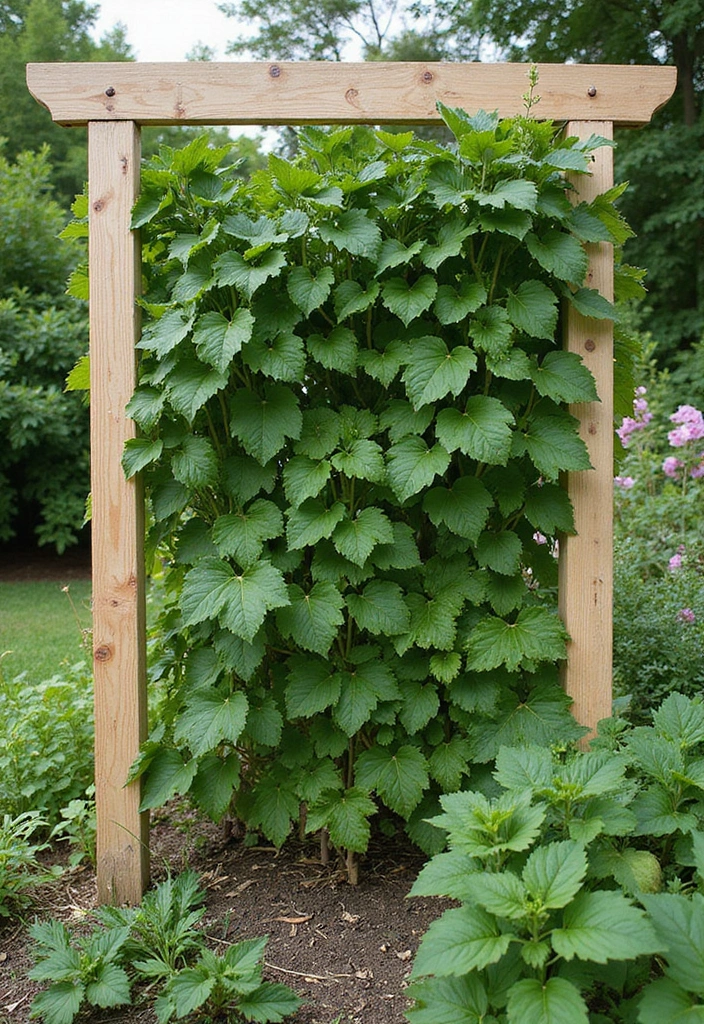
Why not grow your food while creating a privacy screen? A trellis designed for climbing vegetables like beans, peas, or cucumbers can serve dual purposes. This setup maximizes space while providing fresh produce and a green barrier for your garden.
Things to keep in mind:
– Use a sturdy trellis to support heavy vegetables.
– Plant vegetables that thrive in your climate.
– Ensure proper spacing for air circulation.
– Incorporate companion planting for pest control.
This idea adds productivity to your garden while creating a functional and attractive space.
11. Colorful Flowering Shrubs
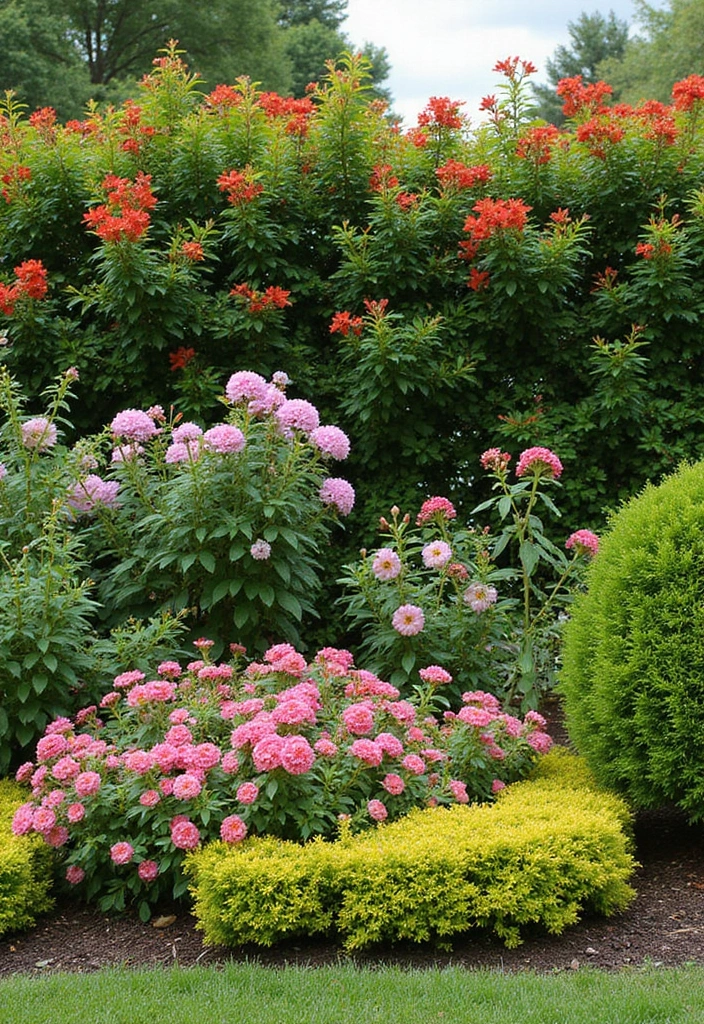
Flowering shrubs like hydrangeas and azaleas can work wonders for privacy while adding a splash of color to your garden. These plants offer a thick foliage that acts as a noise buffer and creates a beautiful backdrop. With different varieties available, you can choose blooms that stay vibrant throughout the seasons.
Consider these points for planting flowering shrubs:
– Select varieties that suit your climate.
– Space them appropriately for future growth.
– Prune after blooming for healthy growth.
– Mix different colors for a stunning display.
Planting these shrubs creates a beautiful privacy barrier filled with delightful fragrances and vibrant colors.
12. Vertical Wall Garden
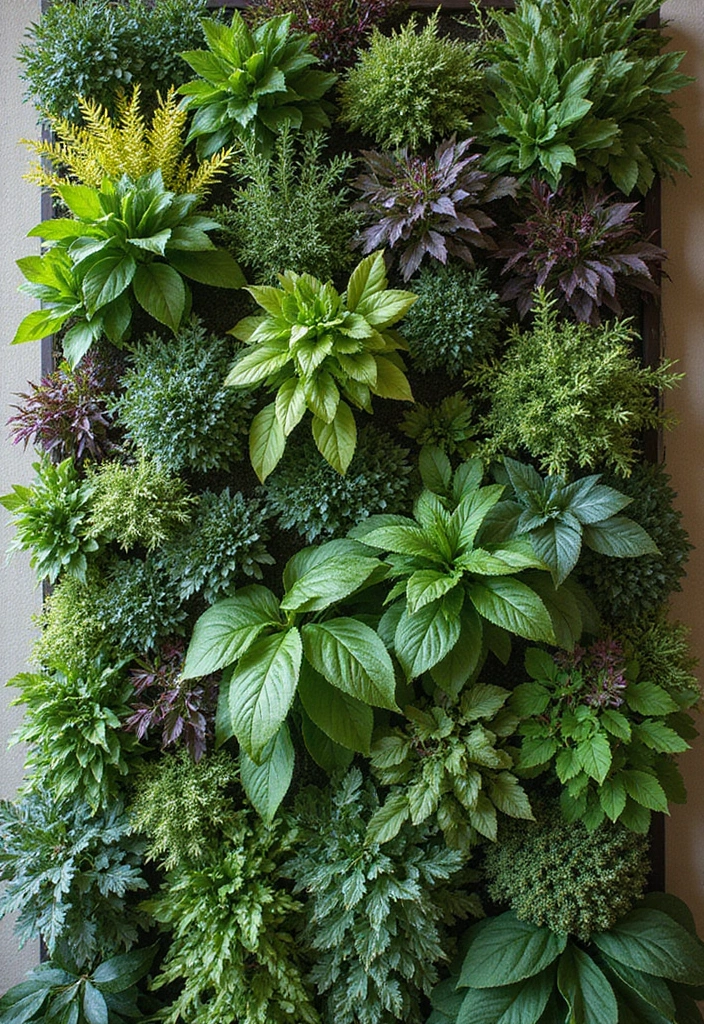
A vertical wall garden not only serves as a stunning focal point but also provides a unique barrier for privacy. This innovative design can include a variety of plants, such as ferns, succulents, and flowering species, creating a living wall that breathes life into your space.
To achieve a vibrant vertical garden:
– Use wall-mounted systems for easy maintenance.
– Vary plant heights for visual interest.
– Ensure adequate light and watering based on plant needs.
– Consider seasonal plants for changing displays.
This design not only adds privacy but also acts as a work of art in your backyard.
13. Edible Landscaping
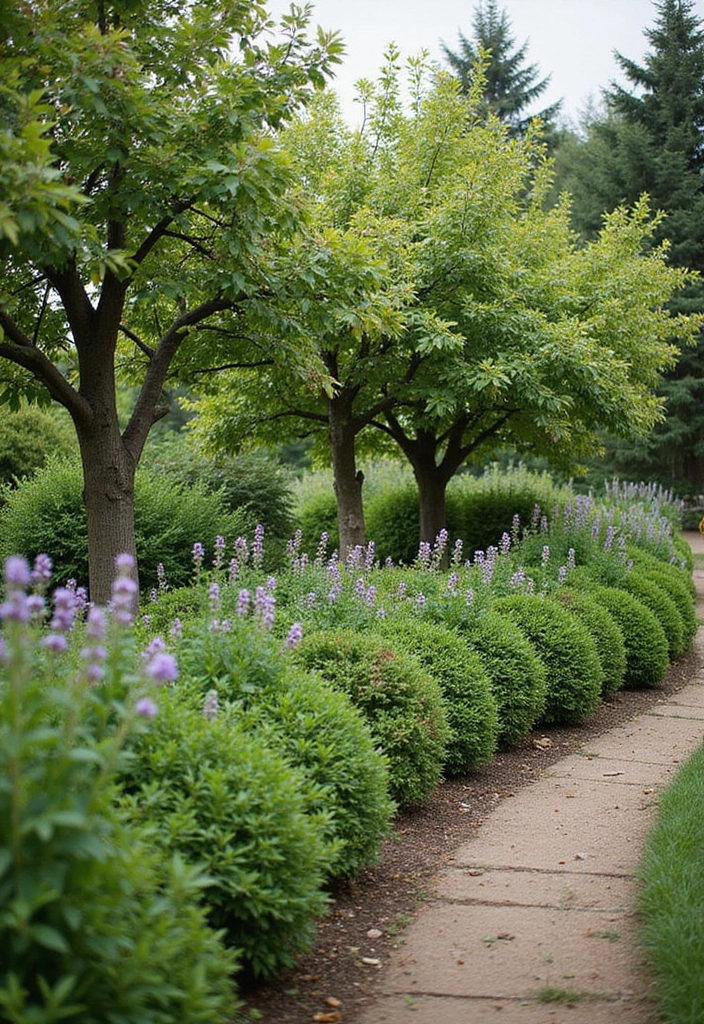
Edible landscaping is a unique way to blend aesthetics with functionality. By planting fruit trees, berry bushes, or edible flowers along your property lines, you create a beautiful barrier that produces food. This approach allows you to enjoy the beauty of your garden while harvesting fresh produce.
Consider these tips for edible landscaping:
– Choose plants that grow well in your region.
– Plan for plants that provide both beauty and fruit throughout the seasons.
– Incorporate herbs for added fragrance and utility.
– Ensure proper spacing for air circulation and sunlight.
This method not only enhances privacy but also makes your garden a productive haven.
14. Ornamental Grasses
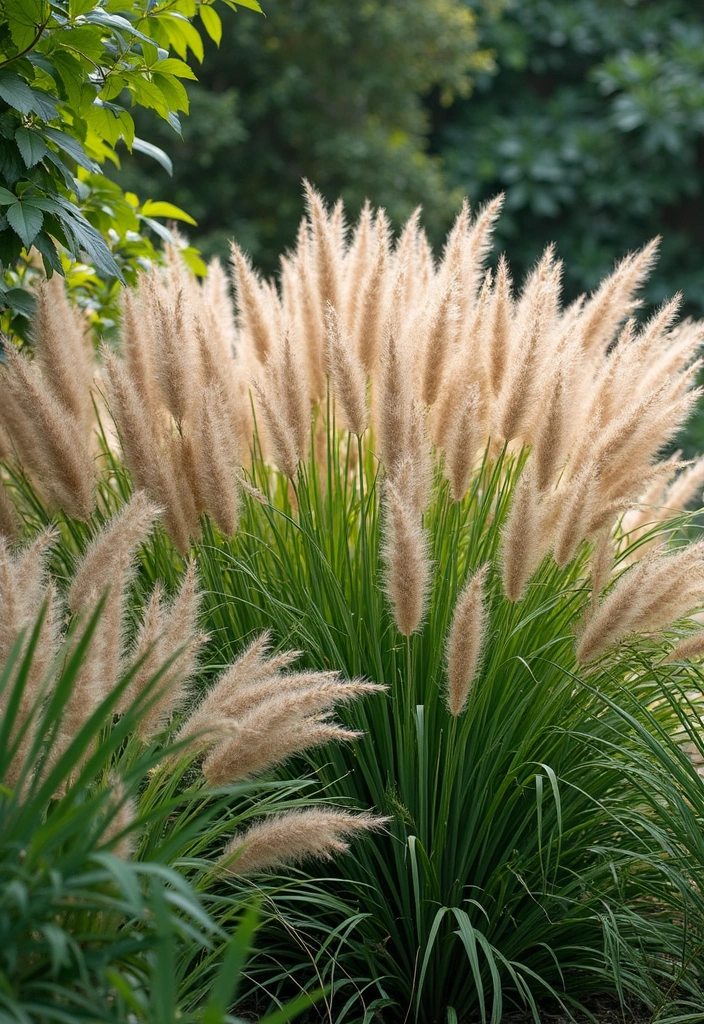
Ornamental grasses can provide a flowing, soft privacy screen that sways gently in the breeze. Varieties like miscanthus, pampas grass, or blue fescue can create beautiful textures and movement in your garden. These grasses thrive in various conditions and are typically low maintenance.
Here are some tips for incorporating ornamental grasses:
– Choose varieties that suit your climate and garden style.
– Plant in clusters for a fuller appearance.
– Regularly trim to maintain height and density.
– Use as a backdrop for flowers for a stunning visual effect.
This addition can make your garden serene and cohesive, offering privacy in style.
Ornamental grasses are nature’s way of softening your space—choose carefully, plant in clusters, and watch your garden dance in the breeze. Enjoy the beauty of low-maintenance privacy!
15. Green Wall with Ivy
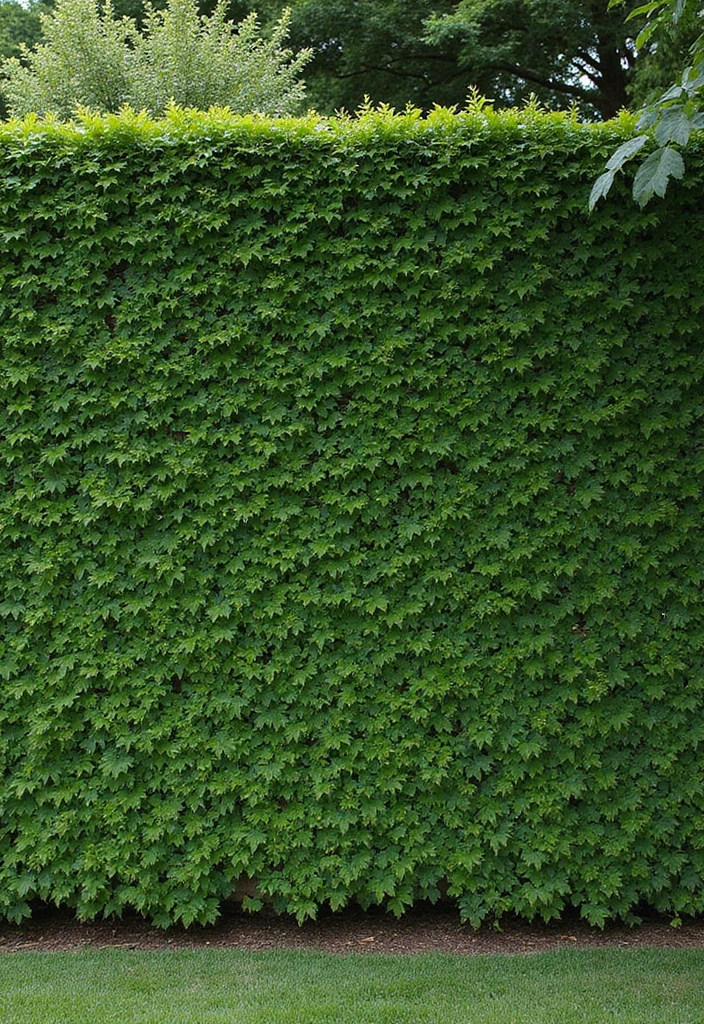
Ivy is a classic choice for creating a green wall that provides both beauty and privacy. This vigorous climber quickly covers walls and fences, creating a dense screen of foliage. Ivy is low-maintenance and can thrive in various conditions, making it an easy choice for many gardeners.
for growing ivy as a privacy screen:
– Ensure a sturdy support structure is in place.
– Regularly prune to manage growth and prevent overreach.
– Combine with perennials for added interest.
– Monitor for pests that may affect foliage.
This timeless plant can create a lush, green atmosphere that feels secluded and intimate.
16. Mixed Container Plants

Creating a privacy fence with mixed container plants allows for flexibility in design. Using different heights and types of plants in containers can establish a vibrant and adjustable barrier. This method is perfect for patios or small gardens where traditional planting isn’t feasible.
Consider these ideas for container gardening:
– Choose a variety of plants with differing colors and textures.
– Use larger containers for stability and impact.
– Regularly rotate plants for seasonal interest.
– Group containers for a fuller, more cohesive look.
This approach offers endless possibilities for creativity while still maintaining privacy.
17. Living Willow Fence
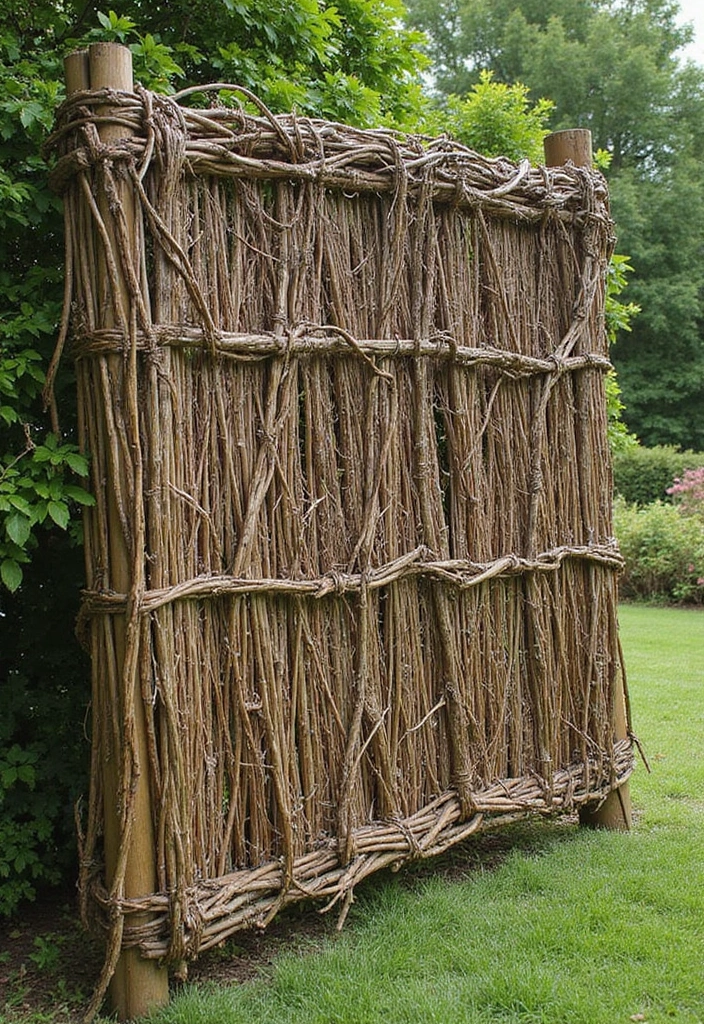
A living willow fence is a natural and eco-friendly option that grows into a beautiful and functional barrier. By planting willow branches close together, you can create a dense, woven fence that provides privacy while still feeling alive. This charm makes it an attractive option for rustic settings.
Ideas for creating a living willow fence:
– Plant willow cuttings in early spring.
– Water regularly until established.
– Prune to maintain shape and density.
– Allow to grow in desired shape for a unique look.
This living fence not only serves practical purposes but also enhances the beauty of your landscape.
18. Standard Trees as a Fence
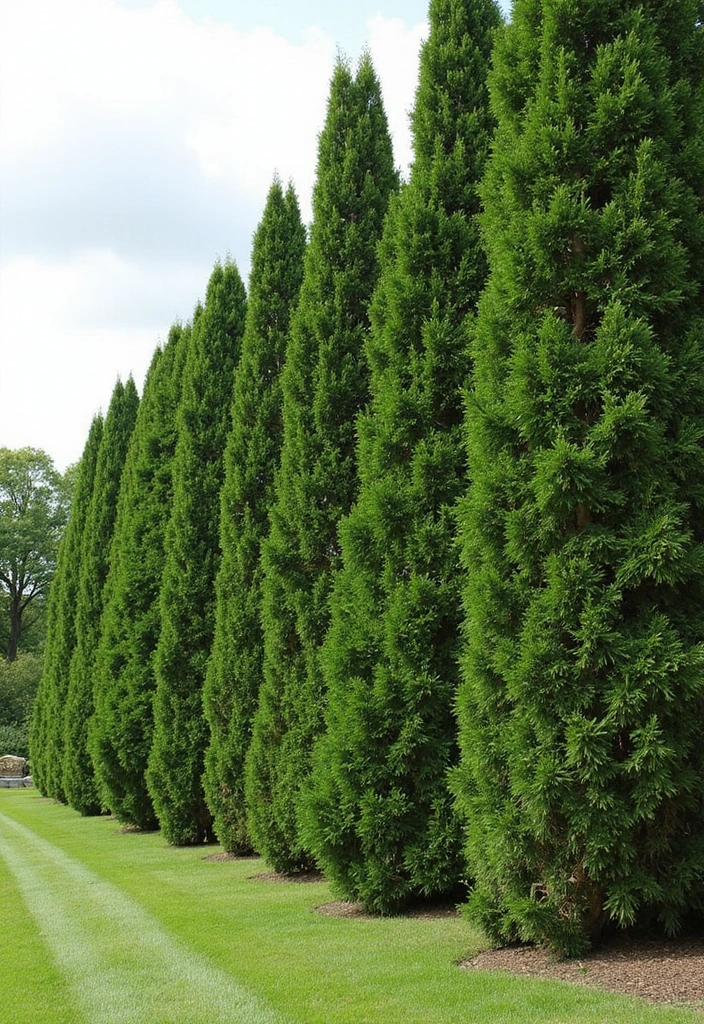
Utilizing standard trees as a living fence is a bold and dramatic solution for privacy. Fast-growing varieties like arborvitae or leyland cypress can provide an impressive barrier, offering shade and shelter as well. This option brings a more traditional and majestic feel to your landscape.
Key considerations for planting trees:
– Choose species that thrive in your climate and soil.
– Plan for their mature height and spread to avoid crowding.
– Ensure proper spacing for air circulation.
– Regular maintenance and pruning can enhance their appearance.
Standard trees not only create privacy but also add substantial value to your property.
19. Colorful Bougainvillea
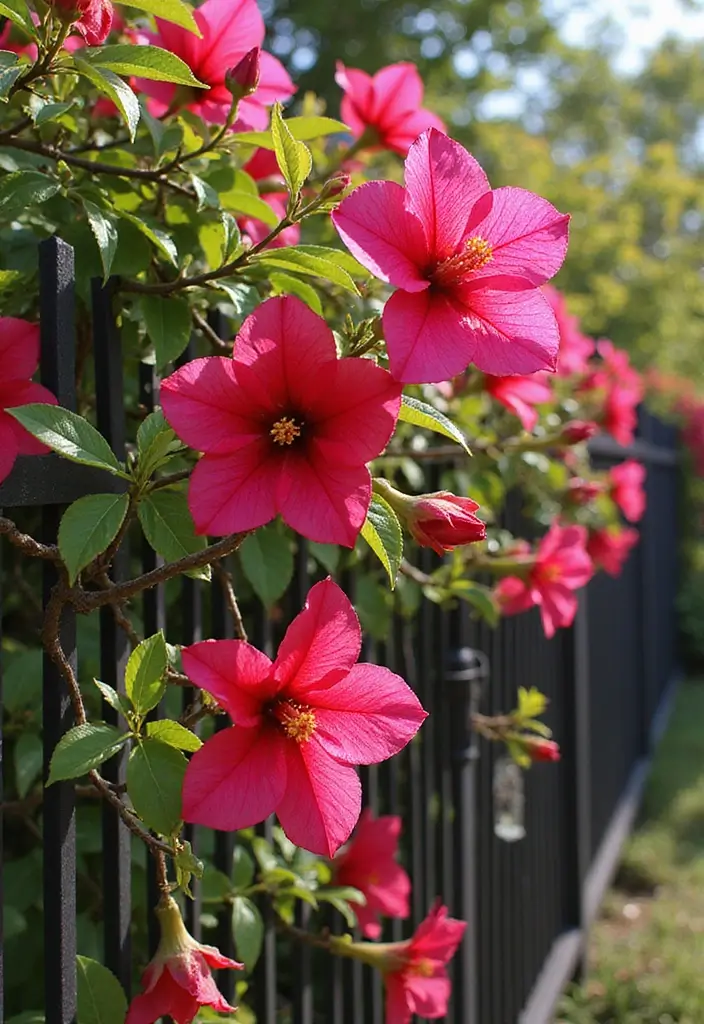
Bougainvillea is a stunning choice for creating an eye-catching privacy screen. With its vibrant colors, this climbing plant can quickly cover fences or walls, providing a burst of color while acting as an effective barrier. Bougainvillea thrives in sunny spots and can be trained to grow on arbors or trellises.
Consider these tips for growing bougainvillea:
– Plant in well-drained soil for best results.
– Prune regularly to encourage blooming.
– Ensure ample sunlight for vibrant color production.
– Train on supports to create a structured look.
This explosive flowering plant not only offers privacy but also adds a tropical vibe to your garden.
20. Hedges for Formal Gardens
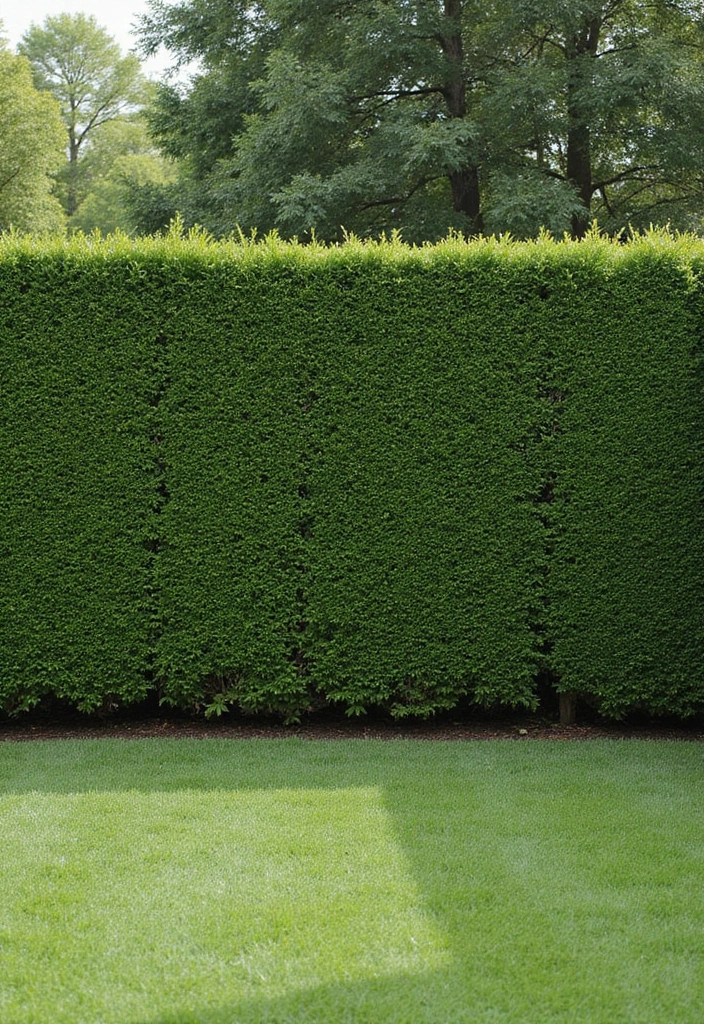
Hedges are a traditional choice for creating privacy in formal gardens. Plants like boxwood or privet can be trimmed into neat shapes, offering a clean and structured appearance. Formal hedges can act as borders or barriers, providing privacy while enhancing the aesthetic appeal of your landscape.
for maintaining formal hedges:
– Trim regularly to maintain desired shape.
– Ensure adequate sunlight and water.
– Use mulch to retain moisture at the base.
– Plan for seasons of blooming for visual interest.
This classic approach can elevate the elegance of your garden while providing the necessary privacy.
21. Mixed Shrub Borders
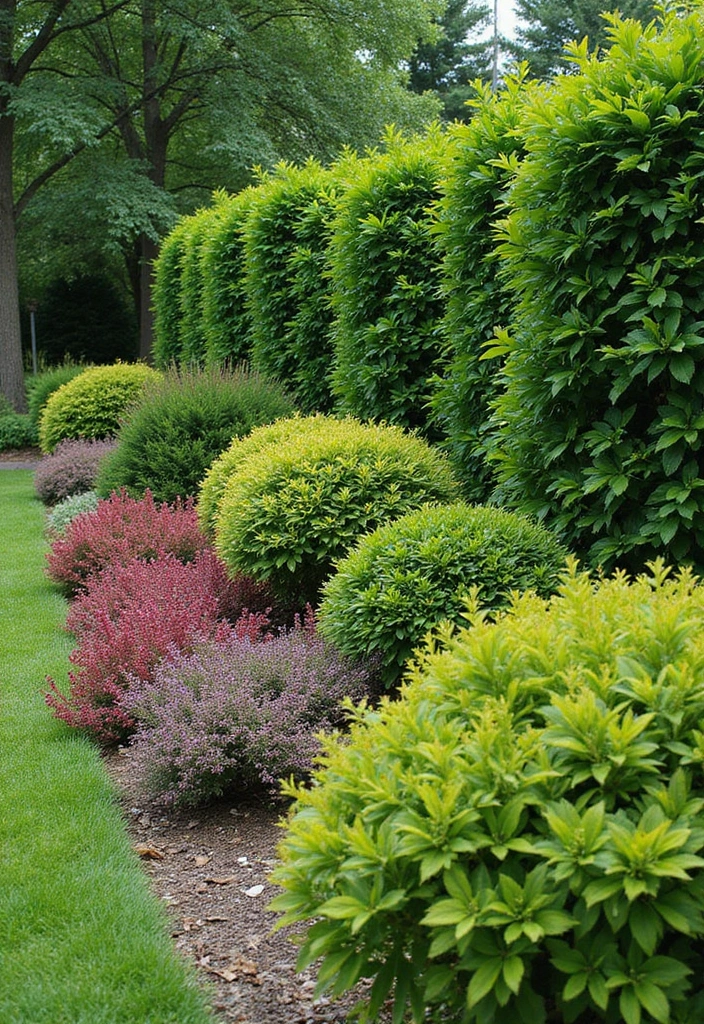
Creating a mixed shrub border is a fantastic way to add a variety of colors and textures while maintaining privacy. By combining different types of shrubs, you can create a lush backdrop that feels alive. Varieties like barberry, rhododendron, and spirea can add interest through the seasons.
Here are some tips for mixed shrub borders:
– Choose shrubs that bloom at different times of the year.
– Layer plants based on height for depth.
– Include some evergreen varieties for year-round interest.
– Regularly prune for shaping and health.
This approach makes for a beautiful, dynamic display that enhances privacy.
22. Living Fence from Native Plants
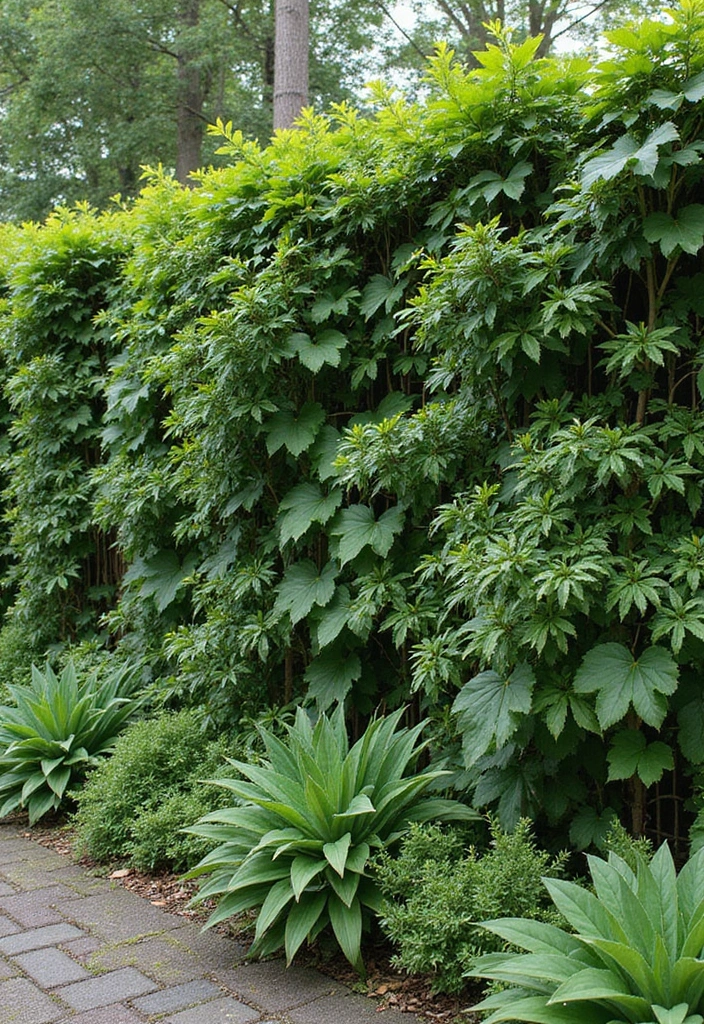
Using native plants to create a living fence not only enhances privacy but also supports local wildlife. Native species are adapted to your area, which often makes them easier to maintain. Plants like elderberry, chokeberry, and serviceberry can create a diverse and beautiful natural barrier.
Benefits of using native plants:
– Low maintenance once established.
– Supports local ecosystems and wildlife.
– Provides seasonal beauty with flowering and fruiting.
– Helps conserve water by requiring less irrigation.
This option adds a sustainable approach to landscaping while providing effective privacy.
23. Green Roof for Privacy
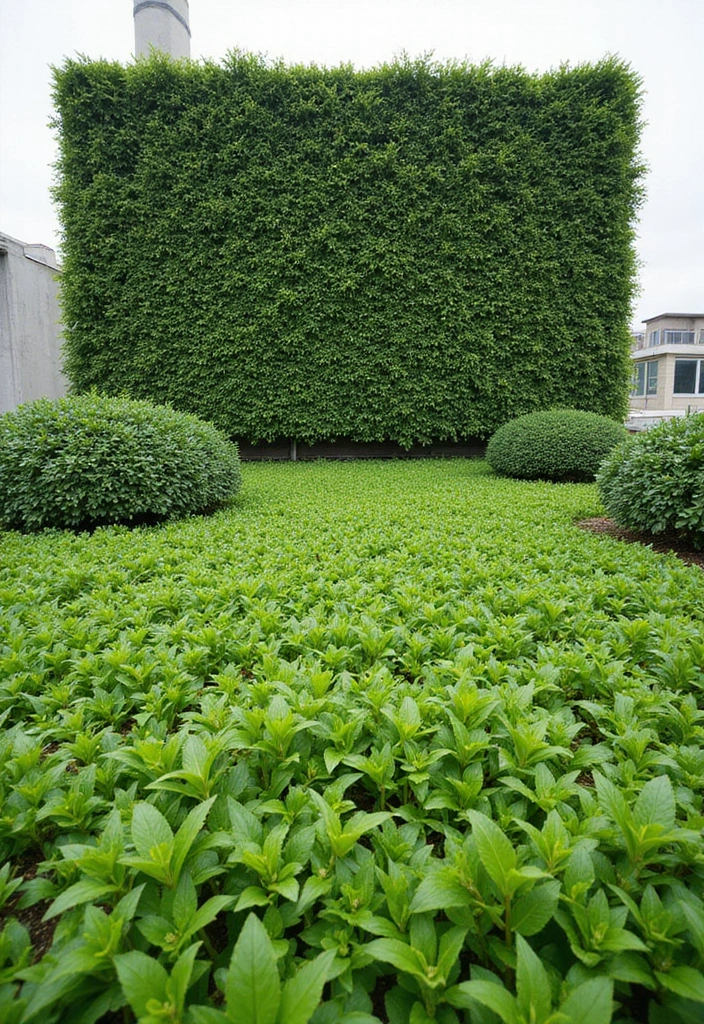
A green roof can provide an innovative solution to privacy while enhancing your garden’s aesthetic. By planting a variety of groundcovers, you can transform a rooftop or elevated deck into a lush, green space. This idea maximizes space while creating a serene escape above ground level.
Considerations for a successful green roof:
– Ensure the structure can support the weight.
– Use lightweight soil and appropriate drainage solutions.
– Choose plants that thrive in your climate and conditions.
– Plan for seasonal changes to keep it visually appealing.
This unique approach creates an unexpected garden element that offers both privacy and beauty.
24. Decorative Screen Planters
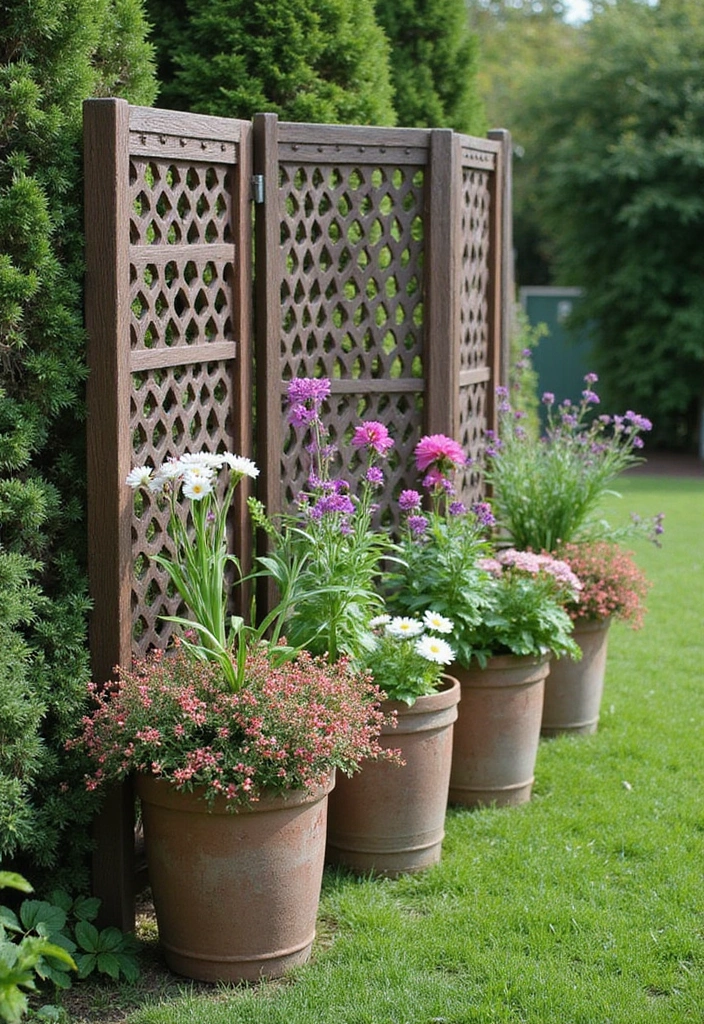
Decorative screen planters can function as both a privacy barrier and a stylish feature in your garden. These planters can be filled with a variety of plants, from colorful flowers to fragrant herbs, offering a beautiful way to separate spaces. They add visual interest while serving a practical purpose.
for using decorative screen planters:
– Choose stylish planters that complement your garden style.
– Fill with a mix of plants for different textures.
– Ensure proper drainage and sunlight for plant health.
– Rotate plant varieties seasonally for color changes.
This option creates a unique vibe, blending functionality with beauty.
25. Fencing with Climbing Roses
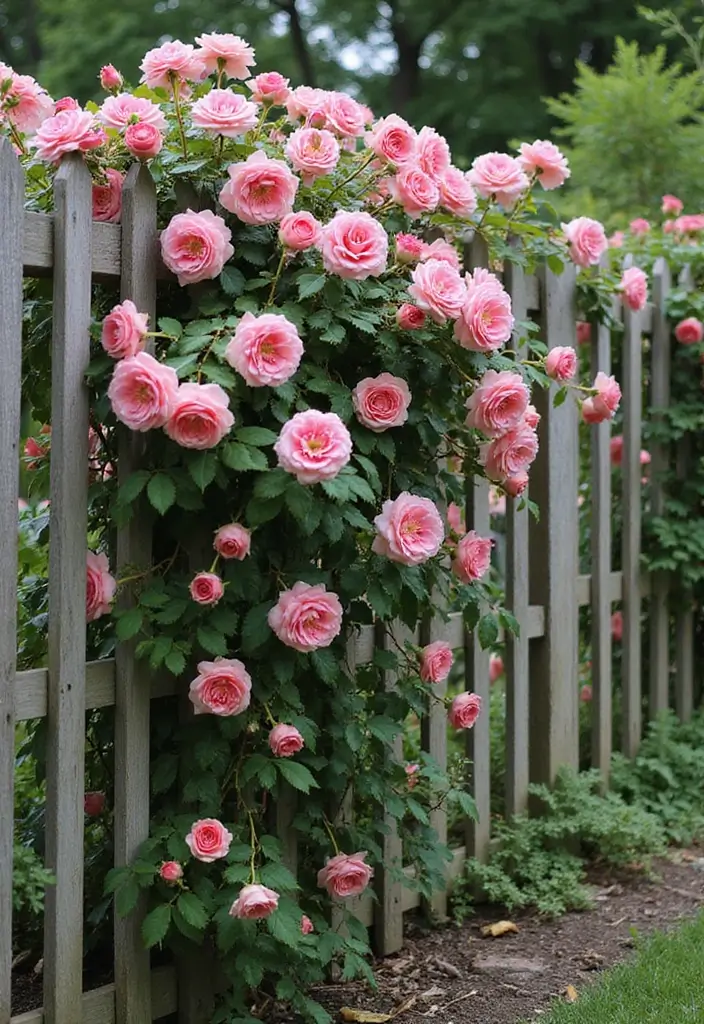
Climbing roses bring romance and charm to any garden while providing a lush privacy screen. They can be trained to climb on trellises or fences, creating an enchanting wall of blooms that smells heavenly. With a variety of colors and fragrances, these plants not only offer privacy but also add beauty to your space.
Key considerations for planting climbing roses:
– Choose varieties suited for your climate.
– Ensure they have a sturdy structure for support.
– Regularly prune to encourage blooming.
– Incorporate companion plants for added visual interest.
This option creates a stunning and aromatic barrier that can make your garden feel like a fairytale.
26. Potted Citrus Trees
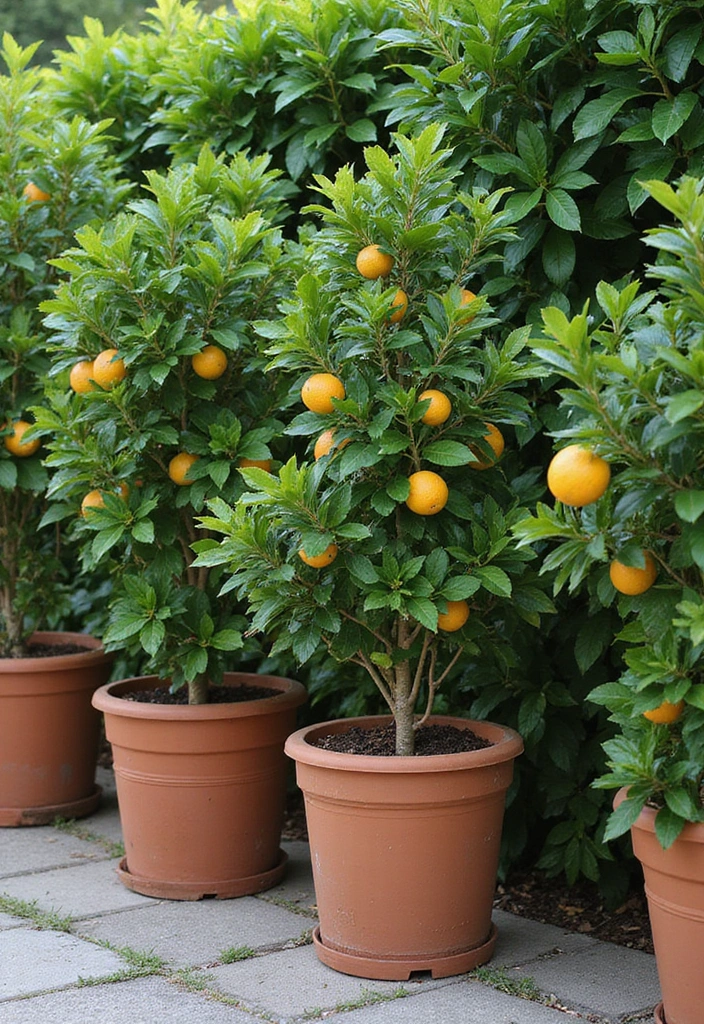
Potted citrus trees can serve as an attractive and fragrant privacy barrier, especially in warmer climates. Varieties like lemon or lime trees can be kept in pots for mobility, allowing you to rearrange your space as needed. This not only provides visual interest but also the added bonus of fresh fruit.
Considerations for maintaining potted citrus trees:
– Ensure pots have adequate drainage holes.
– Use a well-draining soil mix for optimal growth.
– Provide ample sunlight for fruit production.
– Regularly water and fertilize for healthy growth.
This approach combines aesthetics with functionality, delivering delightful scents and fresh produce.
27. Shade-Loving Ferns
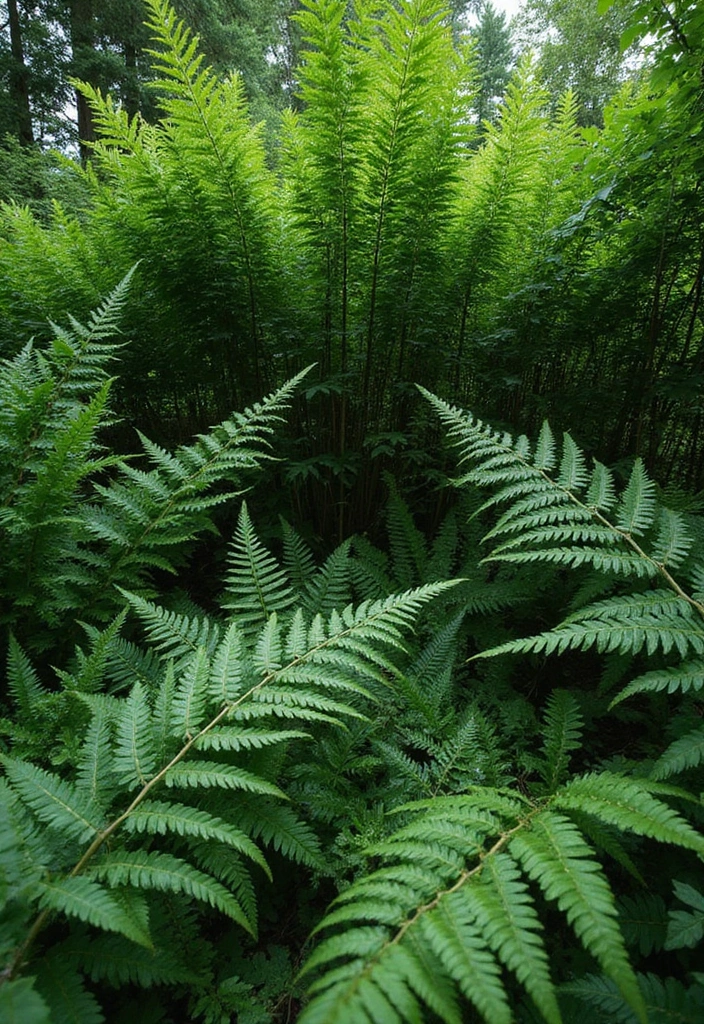
For shaded areas, consider using shade-loving ferns to create a soft, green privacy screen. Ferns like Japanese painted fern or lady fern can grow quickly and create lush foliage, adding a soothing aesthetic to your garden. This solution is perfect for those tricky spots where other plants may struggle.
for growing ferns as privacy barriers:
– Choose varieties that thrive in your local shade conditions.
– Ensure soil is rich and well-draining.
– Water regularly, especially during dry spells.
– Use mulch to retain moisture.
This option creates a tranquil and secluded space that feels intimate and serene.
28. Privacy with Potted Bamboo
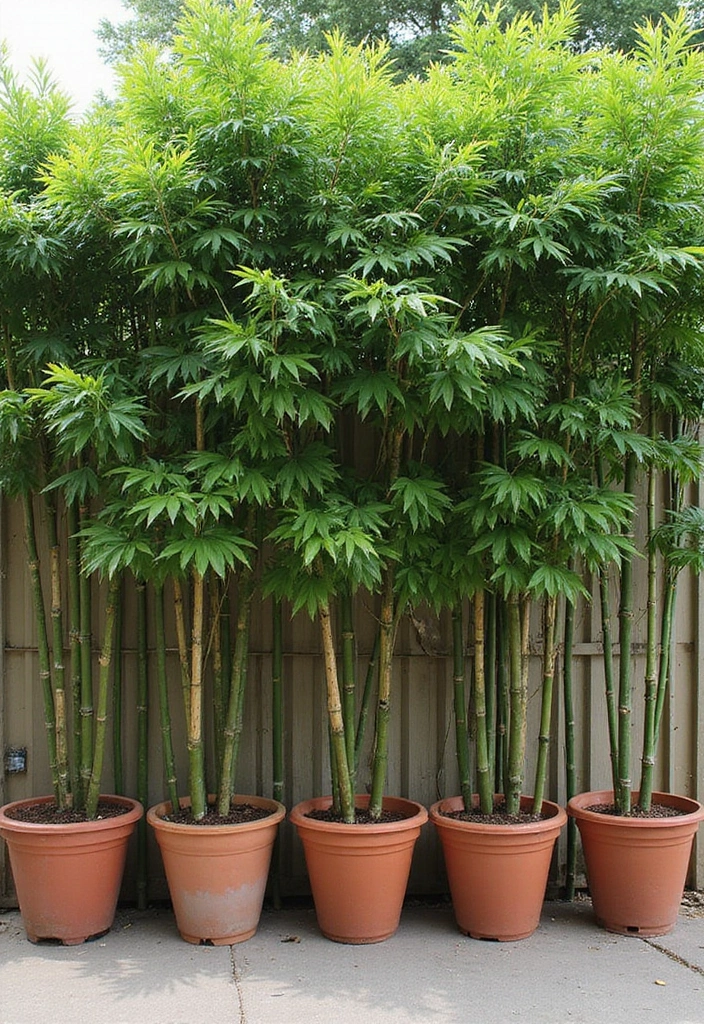
Potted bamboo is a versatile option that allows you to create a living privacy screen that can be moved easily. Bamboo grows quickly and can reach significant heights, making it an effective natural barrier. This solution is perfect for those who wish to maintain flexibility in their garden layout.
Considerations for using potted bamboo:
– Select clumping varieties for easier management.
– Ensure pots are large enough for root growth.
– Water regularly to keep bamboo healthy.
– Regular pruning may be necessary to maintain height.
This approach offers a stunning visual while providing a natural, tranquil feel to your outdoor space.
29. Mixed Herb Garden Fence
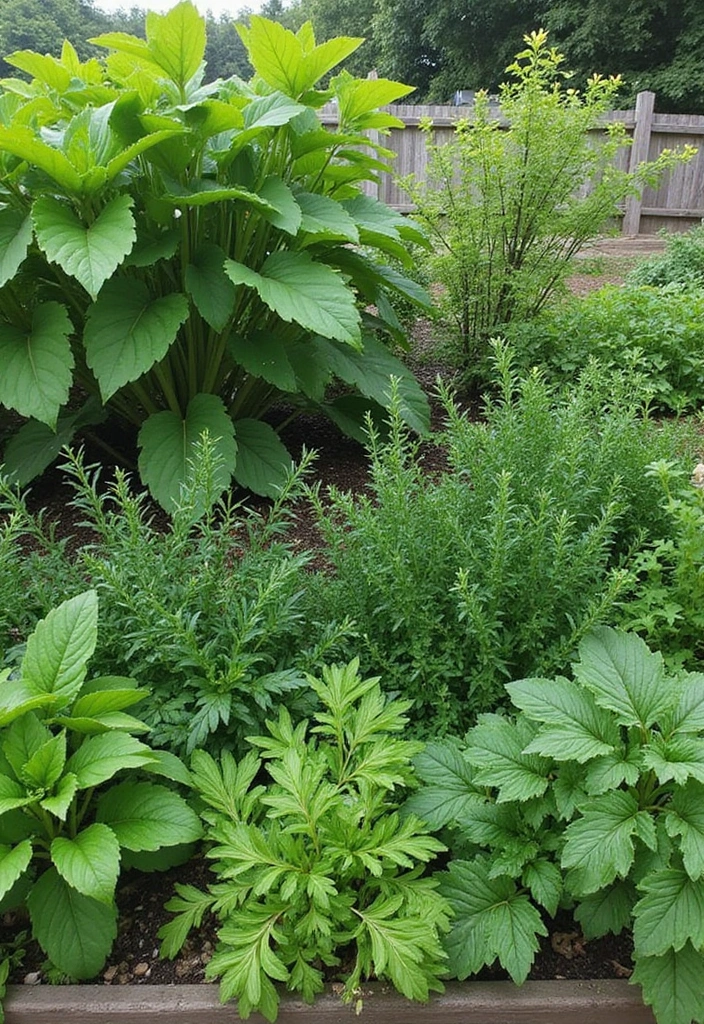
Creating a mixed herb garden fence combines aesthetics with utility, giving you a colorful and fragrant privacy barrier. By planting a combination of herbs like mint, basil, and thyme, you not only enhance privacy but also provide fresh ingredients right at your fingertips.
for planting a mixed herb garden fence:
– Choose herbs that thrive in similar conditions for easy care.
– Plant densely to create a full look.
– Regularly prune to promote healthy growth.
– Incorporate decorative stones or mulch to add visual interest.
This approach allows you to enjoy a fragrant garden while creating a lush barrier.
A mixed herb garden fence not only offers a fragrant privacy barrier but also turns your outdoor space into a culinary haven. Why settle for a plain fence when you can grow your own fresh ingredients?
30. Recycled Pallet Fence Garden
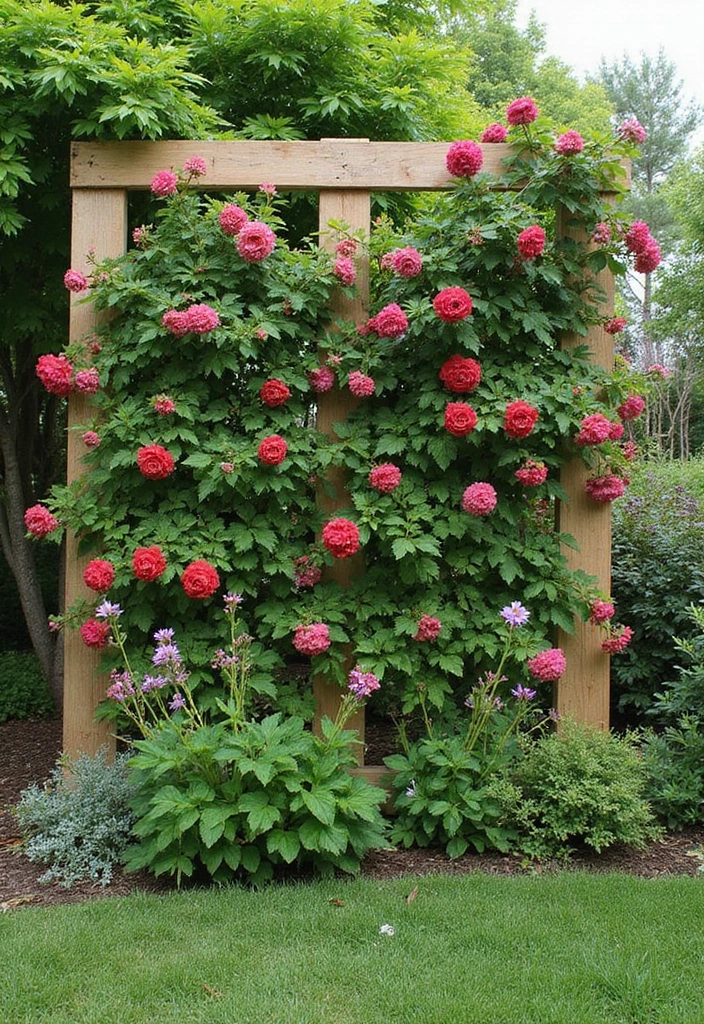
Utilizing recycled pallets for a garden fence is an eco-friendly and creative solution for privacy. By stacking pallets vertically, you can create unique sections of your garden that can be filled with climbing plants or trailing flowers. This rustic look adds character while providing privacy.
Considerations for recycling pallets:
– Ensure pallets are safe for planting; avoid those treated with chemicals.
– Stain or paint for added durability and aesthetics.
– Fill with soil and plants that are comfortable growing in a pallet environment.
– Use as a backdrop for other plants for layered design.
This inventive approach adds charm and creativity while serving as an effective privacy screen.
Transforming recycled pallets into a garden fence not only enhances privacy but gives your outdoor space a rustic charm. Embrace creativity and nature – your garden will thank you!
Conclusion
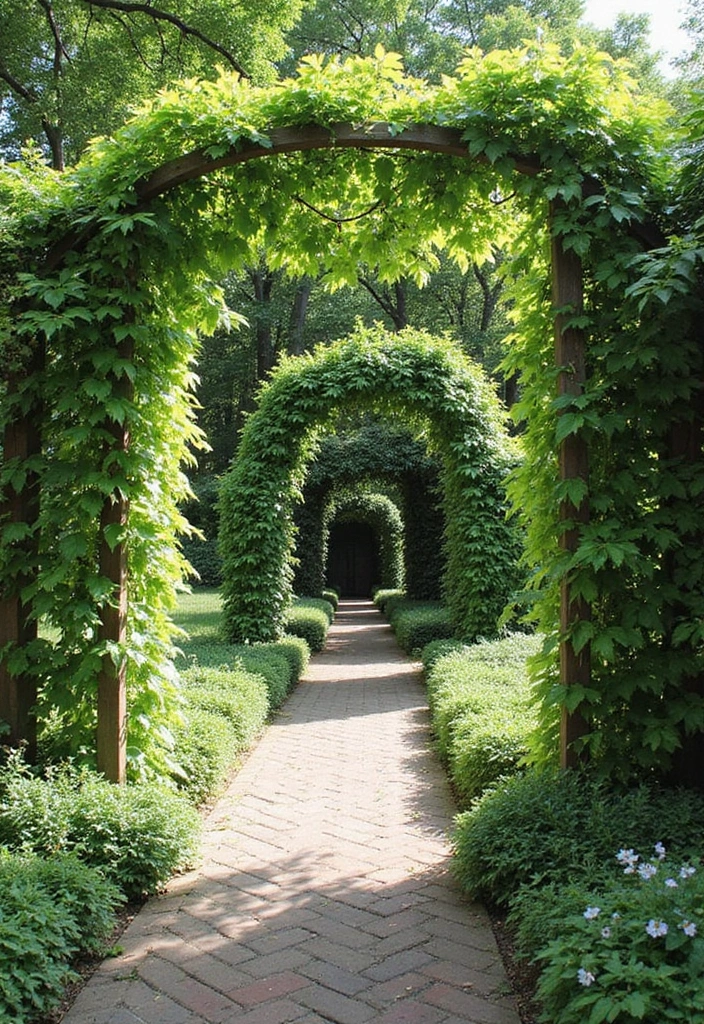
Incorporating plant fences into your garden not only enhances privacy but also adds beauty and character to your outdoor space. Each idea brings its unique flair and sustainability, helping you create a serene escape that is fully functional.
With so many creative plant fence ideas to explore, there’s surely something that aligns perfectly with your vision. So, get ready to roll up your sleeves and transform your garden into a green paradise!
Frequently Asked Questions
What are some easy plant fence ideas for small gardens?
If you’re working with a small garden, don’t worry! There are plenty of plant fence ideas that can fit your space perfectly. Consider using vertical gardens with climbing plants like vines or herbs on trellises to maximize vertical space. Alternatively, potted plants arranged along your garden’s edges can create a lovely border while providing privacy without taking up too much room.
Which plants are best for creating a natural privacy barrier?
For a stunning and effective natural privacy barrier, consider using bamboo for its rapid growth or evergreen shrubs like boxwood and juniper for year-round coverage. Climbing roses and vines such as wisteria can add beauty and fragrance while providing a lush screen. Choose plants that thrive in your local climate to ensure they flourish and do their job!
How can I maintain a plant fence for long-term effectiveness?
Maintaining a plant fence is crucial for long-term effectiveness! Regularly check for pests and diseases, and ensure your plants receive adequate water and nutrients. Pruning is key to encouraging healthy growth and shape. Adding mulch can help retain moisture and suppress weeds. Consider incorporating a variety of plants for a more resilient and visually appealing barrier!
Are there any low-maintenance options for plant fences?
Absolutely! If you’re looking for low-maintenance options, consider using succulents or ornamental grasses. These plants typically require less water and care compared to traditional garden plants. Bamboo is also a fast-growing, hardy choice that requires minimal upkeep. Choose plants that are well-suited to your climate to ensure they thrive with less attention!
Can I create an edible plant fence, and if so, how?
Yes, you can create a beautiful and functional edible plant fence! Consider planting vertical veggies like beans or cucumbers on trellises, or using potted herbs along your borders for easy access. Fruit bushes like raspberries or currants can also add a tasty touch. Incorporating edibles not only provides privacy but also delicious produce for your kitchen!


